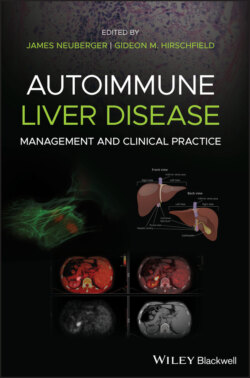Читать книгу Autoimmune Liver Disease - Группа авторов - Страница 51
Central T‐cell Tolerance
ОглавлениеT cells with high affinity TCRs for self HLA–self peptide complexes are eliminated in the thymus by clonal deletion [8]. This process of negative selection favors the survival of T cells with TCRs that exhibit either no or very low affinity for self‐HLA–autoantigen peptide complexes. Among the natural (n) αβT cells selected in the thymus are subsets of CD4 T cells, including nTregs, NKT cells, and IL‐17‐secreting nTh17 cells. Given the dichotomous functions of nTregs and nTh17 cells to suppress versus augment inflammatory pathology, thymic regulation of the balance of these subsets is an important determinant of the risk for autoimmunity. Overall, more than 95% of T cells generated in the thymus undergo deletion because of excessive self‐reactivity, which underscores the high frequency of autoreactive TCRs among T cells.
Negative selection of autoreactive T cells by is mediated by the coordinated display of self‐HLA molecules containing self‐peptides generated by expression of genes controlled by the autoimmune regulator (AIRE) transcription factor. In addition to DCs, medullary thymic epithelial cells (mTECs) selectively express AIRE, which drives tissue‐specific self‐antigen expression required for deletion of T cells with TCRs that react strongly with autoantigens. In addition, thymic B class switching also promotes central tolerance through negative selection of CD4 T cells. The importance of AIRE in central tolerance is underscored by the consequences of genetic AIRE deficiency in humans, which results in an autoimmune disease characterized by autoimmune polyendocrine syndrome type 1 (APS‐1) [1]. AIRE is also involved in peripheral T‐cell tolerance and is expressed in peripheral lymph nodes and the spleen where it mediates elimination of autoreactive extrathymic T cells.
Thymic editing of TCRs plays a seminal role in the genesis of the TCR repertoire and is mediated by recombination activating gene (RAG)‐1 and RAG‐2 proteins. After RAG proteins are induced during T‐cell development, they cause TCR β‐chain rearrangement and expression of prefabricated TCR α‐chains to form pre‐TCRs. A subsequent round of RAG protein induction transcribes rearranged TCR α‐chains that displace prefabricated α‐chains. Yet another round of induction of RAG proteins finalizes rearrangements of α‐chains, forming functional α/β TCRs to undergo thymic selection. This thymic process of TCR editing has a counterpart in the periphery, referred to as TCR revision, which can generate an unlimited array of antigen‐specific TCRs, overcoming the effects of thymic TCR selection. These newly generated TCRs likely contribute to peripheral creation and evolution of autoreactive T cells (discussed later).
